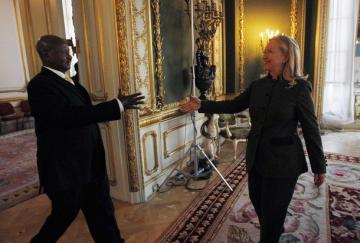
This oped originally appeared on Foreign Policy.
After their meeting in early August, U.S. Secretary of State Hillary Clinton and Ugandan President Yoweri Museveni didn't say that the United States and Uganda are the only two countries — working together — that have the best chance of bringing an end to the Lord's Resistance Army (LRA). But that is the stark reality. After all the global attention heaped on Joseph Kony, the LRA warlord wreaking havoc throughout a handful of central African countries, it turns out that the existing plan for bringing him to justice isn't going to work. U.S. Special Forces deployed 10 months ago to support the mission are sitting on their hands because they are not tasked with directly accompanying Ugandan forces in their pursuit of Kony and the LRA. And Uganda, the only country whose army is undertaking offensive operations against the LRA, is rapidly pulling its forces out of the war theater as it redeploys its forces to Somalia. If the United States and Uganda don't change the plan quickly, it will fail.
All available intelligence shows that the largest LRA concentrations are in the northeastern corner of the Central African Republic (CAR). Reportedly, some forces are crossing the border into southwestern Darfur, Sudan, possibly to get resupplied. That is where Kony himself is thought to be. Other LRA units are carrying out frequent attacks in northeastern Democratic Republic of the Congo.
The one thing those locations have in common is that they are all currently inaccessible to Ugandan and U.S. forces. The Ugandans are concentrated far south of where Kony and his commanders are thought to be hiding in CAR, and they are not allowed sustained access into Congo or Sudan.

A shadow of its former self, the LRA consists of perhaps 300 hard-core fighters, served by hundreds more abducted children. This is down from its heyday a decade earlier, when LRA troop strength was in the thousands and the regime in Khartoum, Sudan, was providing sanctuary, weapons, and funding. Given their weakened state today, this is a winnable war.
Since the Kony 2012 video went viral with its 100 million views, many governments around the world have pledged their support for the mission to defeat the LRA once and for all. Despite all the rhetorical support, the military mission is missing five major ingredients for potential success.
First, high-level diplomacy must convince governments whose territories are being used as hideouts for Kony and his henchmen to allow sustained access to no-go areas in CAR, Congo, and Sudan. The United Nations General Assembly meeting in September could provide a forum for critical deal-making in this regard.
Second, further intelligence is needed. We still don't know exactly where Kony is. An intel surge accompanied by preparations for acting on the yield from that information should be prioritized. Additionally, forward deploying a U.S. surveillance aircraft closer to Kony's hideouts will yield much better intelligence than the current planes, which use most of their fuel flying from distant locations.
Third, Uganda needs to deploy an elite commando unit to undertake operations with more direct U.S. support, training, and planning. The Ugandan military pursuing Kony is down to 800 troops — over an area the size of Arizona.
Fourth, the Ugandan troops need helicopters to move around that huge area. Right now, even if there were a hot lead on exactly where Kony is hiding, the forces could not get there in time because of a lack of helicopter support.
Fifth, the U.S. Special Forces need to be taken off the leash. President Barack Obama was right to deploy the military advisors, and Congress was right to support the mission. But now their rules of engagement need to be enhanced beyond merely training to involvement in operations. With them working closely with the Ugandans in areas near where Kony and other top LRA commanders are believed to be hiding, a more direct U.S. role in supporting Ugandan commando operations could yield a much quicker successful conclusion to the mission. More political pressure on CAR, Congo, and Sudan to allow access to no-go zones will also help. But absent a direct U.S. role and a reinvigorated Ugandan deployment, the operation stands no chance of success.
The Osama bin Laden mission was ultimately successful because the right assets were collected and aimed at the right location. The international geopolitical investment is understandably much lower for the Kony mission. But the bar is lower as well: The kind of investment needed to see this operation to a successful conclusion involves a decision to allow U.S. forces already in place to become more operational in support of Ugandan operations against Kony and other top leaders, which will require an intel surge and additional transport. And beyond saving lives it will save money — shortening the deployment of U.S. forces and reducing the amount of dollars spent on the humanitarian operations of taking care of the tens of thousands of people who become displaced every year by the LRA's callous and persistent attacks.
Photo: Secretary Clinton and Ugandan President Museveni

